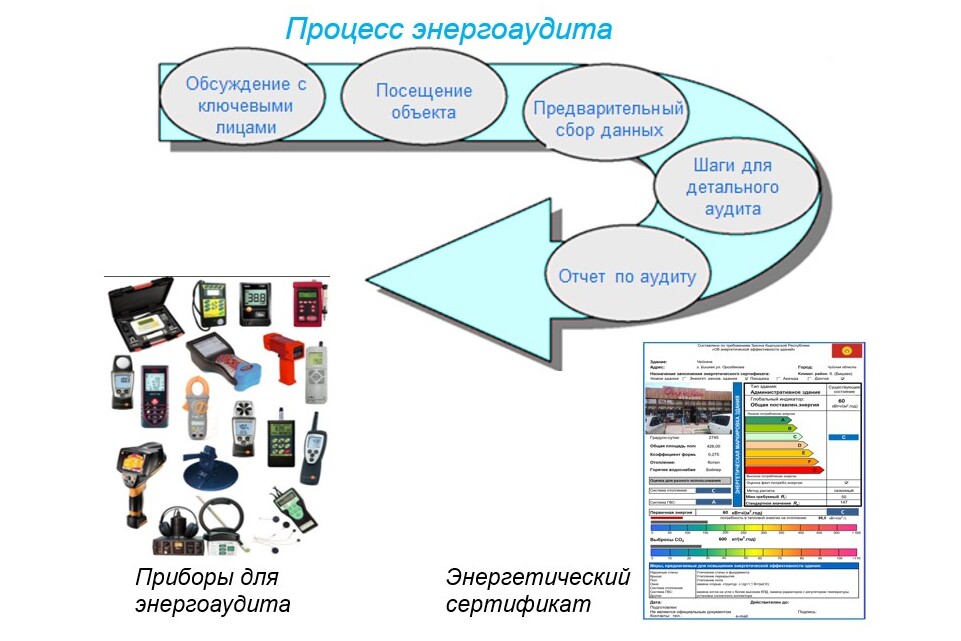
Еnergy audit is an assessment of the state of a building in terms of the consumption of various types of energy, including heating, water, etc., in order to determine cost-effective measures for the production and consumption of energy.
Purposes of energy audit:
- search and elimination of energy loss;
- reduction of costs for electricity, heat, water, gas;
- increasing the level of comfort in buildings and structures;
- improving the energy efficiency of equipment;
- optimization of activities and cost reduction of enterprises and organizations.
Organizational energy audit processes are based on a specific methodology, which is developed on the basis of specific regulations and laws of the Kyrgyz Republic on energy efficiency (see Chapter 4). The methodology includes: i) review of files related to building design and construction; ii) individual meetings with authorized management, technical staff and users; iii) thermal imaging and calculation to detect heat leakage, as well as compliance with indoor temperature and humidity standards. All collected data is entered and analyzed on ready-made and automated models developed in Excel. One of these models allows you to obtain an energy certificate for a building.
Another tool allows you to calculate the current state of energy consumption of buildings and offers recommendations for achieving class “B” status, which is a specific requirement of the Law of the Kyrgyz Republic “On the energy efficiency of buildings”. Excel calculations also offer packages of energy saving measures. The energy audit report consists of three main sections: i) the technical characteristics and condition of the building and its major systems; ii) building energy analysis; iii) a list of recommended activities, investments and benefits. Finally, recommendations on energy efficiency measures, taking into account general economic and financial trends, are presented on the basis of the current market value of energy efficiency materials and equipment.
Building survey includes:
- Examination of the enclosing structures and foundations of buildings;
- Measurement of energy carriers'/fuel’s consumption rates;
- Thermal imaging survey;
- Electricity quality check;
- Air tightness measurements;
- Examination of the boiler and boiler equipment;
- Measurement of parameters of electricity and gas environment.
Energy audit is divided into:
- preliminary (overview audit),
- detailed (investment audit with the development of an investment plan),
- monitoring (subsequent audit).
Energy certification is a government measure aimed at ensuring that construction meets energy efficiency and environmental safety requirements. As a recognized method for evaluating the energy performance of new and existing buildings, energy certification of buildings defines an energy performance class and provides information to improve the energy performance of buildings. Energy performance assessment methodologies typically use software or Excel spreadsheets to calculate the energy performance of buildings, which is often expressed in specific energy units such as kWh/m2 per year and CO2 greenhouse gas emissions in kg(CO2)/m2 per year. The conditions and procedure for the energy certification of buildings are enshrined in the Law of the Kyrgyz Republic “On Energy Efficiency” No. 137 dated July 26, 2011, the Resolution of the Government of the Kyrgyz Republic “On Approval of the Regulations on the Procedure for Conducting Energy Certification of Buildings and the Regulations on the Procedure for Periodic Control of the Energy Efficiency of Boilers, Heating Systems and Hot Water Supply buildings” No. 531 dated August 2, 2012. An energy certificate is developed and issued by a specialist who has a qualification certificate in the field of energy certification of buildings.